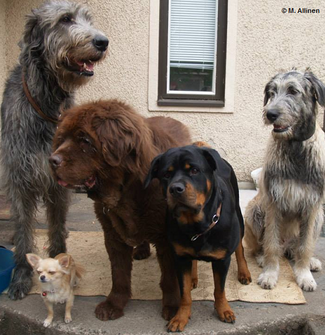Large body size
Dogs are extremely variable in body size: the largest breeds can weigh over 40 times more than the smallest. Although half a dozen genes that regulate dog body size are already known, they mainly explain the differences between small and medium-sized breeds, whereas the genes that govern extremely large size remain mostly unknown. Many large breeds have characteristic health problems - including a high incidence of a particular type of cancer, osteosarcoma - which may relate to the cell-level mechanisms regulating growth and individual size. Therefore, increased insight into the genetic determinants of large body size can also have direct practical importance on dog health.
Study breeds:
 Kuva M. Allinen |
The project focuses on breeds that are large, for example:
- Great Dane
- Irish Wolfhound
- Saint Bernard Dog
- Leonberger
- Mastiff
- Neapolitan Mastiff
- Pyrenean Mastiff
- Spanish Mastiff
- Tibetan Mastiff
We currently collect samples of the breeds that are underlined in the list above, as well as other large breeds that are underrepresented or missing from the Canine DNA Bank (see sample collection of rare breeds).
Dogs eligible for study:
We welcome samples from dogs that are generally healthy and are not closely related.
Copies of diagnoses and other information needed:
Because the project studies a breed-specific character, individual health details are not as crucial as for disease gene studies. It is sufficient to provide general health information about the dog, preferably through our electronic health questionnaire. We also need to know the dog's pedigree. If the dog has been registered by the Finnish Kennel Club, we will get this information from KoiraNet, but for other dogs we wish to receive their pedigree along with the samples.
Links:
Further information on sending blood samples.
A sample form to be sent along with the blood samples.
An electronic form for details and updates of dog's health and owner's contact information.